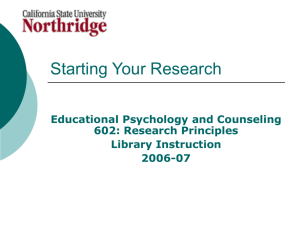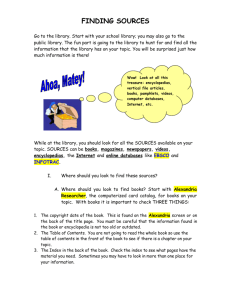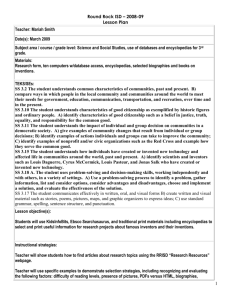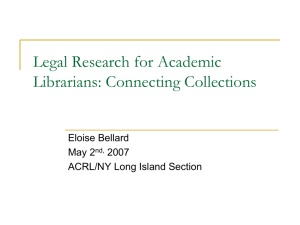LIB 1010: Module 1
advertisement
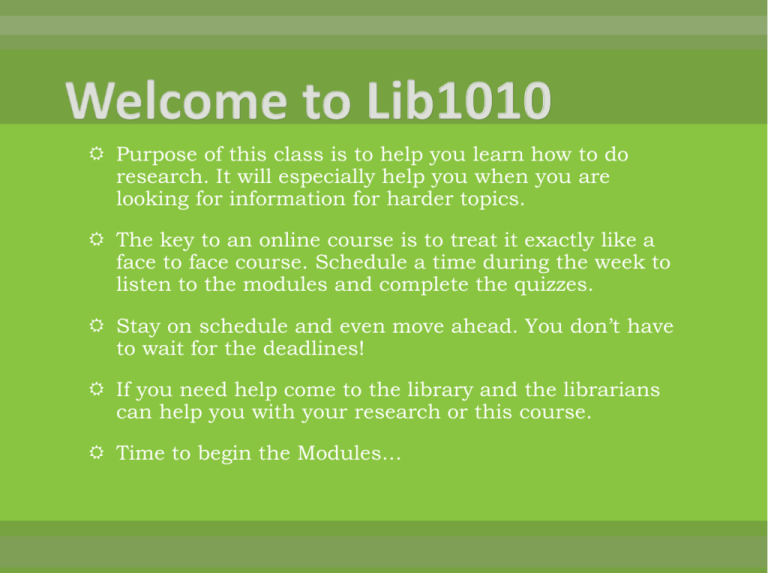
Purpose of this class is to help you learn how to do research. It will especially help you when you are looking for information for harder topics. The key to an online course is to treat it exactly like a face to face course. Schedule a time during the week to listen to the modules and complete the quizzes. Stay on schedule and even move ahead. You don’t have to wait for the deadlines! If you need help come to the library and the librarians can help you with your research or this course. Time to begin the Modules… Beginning an Information Search © 2009 Val A. Browning Library What is information literacy? Literacy = competency Effectively able to use information “A set of abilities requiring individuals to ‘recognize when information is needed and have the ability to locate, evaluate, and effectively use the needed information.’” (ALA 1989) Information literate people “have learned how to learn.” “They know how to learn because they know how knowledge is organized, how to find information, and how to use information so that others can learn from them. These people are prepared for lifelong learning because they can always find the information needed for any task or decision at hand” (Angeley and Purdue). Information literacy is common to all disciplines, to all learning environments, and to all levels of education. It enables learners to master content and extend their investigations, become more selfdirected, and assume greater control over their own learning. According to the Association of College & Research Libraries, an information literate individual is able to: Determine the extent of information needed Access the needed information effectively and efficiently Evaluate information and its sources critically Incorporate selected information into one’s knowledge base Use information effectively to accomplish a specific purpose Understand the economic, legal, and social issues surrounding the use of information, and access and use information ethically and legally. If you believe you are already information literate, consider taking the Test Out Exam Only available during first week of the semester No penalty However, if you are unsure about how much you know, consider the following: Spring 2006, Education Testing Service (ETS) tested 6,300 college students’ information literacy skills and their findings showed that improvement is needed Evaluating web sites: Only 52% of college students correctly judged objectivity Only 49% selected the one web site that met criteria for timeliness, objectivity, and authority When searching a database: Only 50% used a strategy that minimized irrelevant results Selecting a research question for an assignment: Only 44% selected a statement that met the demands of the assignment When asked to narrow an overly broad search: Only 35% selected the correct revision Knowledge workers are information literate Bureau of Labor Statistics Knowledge workers (professional, managerial, and administrative) Duties most highly valued are cognitive (related to thinking, learning, and problem solving) The type and quality of information source required varies with the circumstance. Finding, evaluating, and integrating information – into both one’s own knowledge base and the project at hand – are major skills that students must learn and frequently use. While discipline specific information sources and research techniques do exist, there are basic practices that will create a foundation for information gathering and use in all academic situations. Business Market research Use of critical information to make the best decisions “Search smarts” – locating information Health Good or dangerous information? Need for appropriate evaluation criteria Most important attributes a job seeker can have: 1. Communication Skills: Listening, verbal, and writing 2. Analytical/Research Skills: Deals with your ability to assess a situation, seek multiple perspectives, gather more information if necessary, and identify key issues that need to be addressed. Primary sources Original Non-interpreted Unevaluated Examples: creative works, legislation, original research, raw statistics, some government or organizational documents, personal narratives, diaries, correspondence, some photographs, interviews, and some scholarly articles that report results of original research. Certain newspaper articles reporting events and not offering any analysis or interpretation are primary sources. Secondary sources take information from primary sources and: Summarize Analyze Evaluate Interpret Commentary Discussion Examples: scholarly periodicals and books, magazine and newspaper articles, textbooks, works of criticism and interpretation, works that analyze events or creative works. Some secondary sources can contain primary source material. Tertiary sources appear last in the publication cycle Compile and digest secondary sources Focus on factual information Examples: encyclopedias and other reference books Print publications are not necessarily accessed in print form (electronic versions) Periodicals: published at regular intervals (more than once each year) as opposed to books, which are published once. Scholarly journals Trade publications Popular (or general) magazines Newspapers Authoritative authors (experts with qualifications listed) Peer review (more experts!) Research based (contain critical analysis or original findings) Sources listed (bibliography) Technical academic language in a formal tone Long articles (10+ pages not uncommon) Examples: Journal of Geology, American Art, Ethnomusicology, Evolution, Social Psychology Quarterly Published by professional or other associations, catering to a single-interest group. Authors may be specialists in that industry Authors frequently mention sources, but rarely formally cite them in bibliographies Audience is composed of members of that profession or industry Images are often colorful, and advertising is common No peer review process Examples: Nursing, Reading Teacher, Concrete Monthly, Teddy Bear and Friends Geared toward general public Usually published weekly or monthly Meant to inform and/or entertain Easy-to-read Authors are magazine staff members or freelance writers Authors may mention sources, but rarely formally cite them in bibliographies Contain numerous advertisements and colorful illustrations No peer review process Examples: Newsweek, Road and Track, Consumer Reports, Sports Illustrated Cosmopolitan, Rolling Stone Usually local or regional (some, like Wall Street Journal and USA Today have a national audience) Usually published daily or weekly Short accounts (reporting) of events to a wide audience Printed on inexpensive paper and contain many advertisements Authors can be local staff, newswire reports, or columnists. Focused on current events, often with a regional or local emphasis. Politics, sports, and business are common topics. Examples: New York Times, Wall Street Journal, USA Today, Salt Lake Tribune, Spectrum Both general and specific information Usually essential in research process for undergraduate students Books cover the full range of content, and due to their length, topics can be explored in depth. Some books are compilations of individual articles by a variety of authors. Books are of course available in print, but increasingly they are also available in electronic format and can also accessed through the Internet. E-books have full-text searching capabilities (every page of every book!) Different formats of information are useful for different purposes Periodicals – current, specific Books – in depth and specific, not current Encyclopedias – background information, not current Different formats of information have different content! What you find in a book, you won’t necessarily find in a journal; the content of a newspaper is very different from the content of an encyclopedia. What you need to know and your purpose will dictate the type of source you look in. Popular sources are derivative College students are expected to seek out the best – scholarly – sources available Type of assignment determines the types of information required How much? To answer question At least 2 sources per page of written work Does it need to be current? Get up-to-date information, but don’t neglect background Are there specific requirements? If the assignment requires scholarly material, then focus on that Do you need multiple perspectives or points-of-view? Specific sources can help with this (CQ Researcher) Will I need to order materials? Leave enough time to get what you need! A quick look at resources to determine the appropriateness of a topic based on the amount and type of information found Search the World Wide Web – not the first place to look for actual sources, but useful in choosing a topic. Don’t look for actual sources, ask these questions: Are the web sites found good quality sources? Are there so many that the topic should be narrowed? Does it look like there’s enough good information to support this topic? Most effective method: 1. Consult a subject-specific encyclopedia to find background information, refine your topic, and learn terminology useful for later searching 2. Search the library catalog for books, e-books, videos, and other materials on your topic 3. Look in periodical databases for articles about your topic 4. Explore the World Wide Web using a search engine to find quality web sites with good information for your topic Heaviest to lightest! A good way to remember the order for effective research is that the sources go from the encyclopedias (heaviest) to books, which are a bit lighter than encyclopedias to articles (only a few pages) to Web sites (which don’t weigh anything at all!) Find the best sources Be able to evaluate the worth of the information found Gateway to expensive resources Books & More Encyclopedias Library Catalog for books Article Databases General / Multi-Subject Subject Library Home Page > Research Guides Librarians have created helpful research guides for many subjects, including: Citations (MLA and APA) Reference Education Communication Health Sciences More 1. Start early! (as soon as you receive the assignment) 2. Follow the research plan 3. Use a variety of quality sources (encyclopedias, books, articles, authoritative web sites, etc.) 4. Ask for help if you need it! Librarians are experts in information! We’re here to help! Don’t be frustrated; contact the human search engine – your librarian! Text-a-librarian (Text DSClib to 66746) Chat with a librarian (Click on “Ask a Librarian”) In person at the Library Reference Desk Check the library home page for times (library.dixie.edu) Email us (reference@dixie.edu or use “All Instructors” in Canvas) By telephone: Reference (435) 634-2081 Circulation (435) 652-7714 You’re now ready to take Quiz 1. It’s located in Module 1. Although the quiz is open book, remember that the Final Exam is not, so you’ll need to actually be learning the content not just filling in the bubbles. If you have any questions or run into any problems, please let us know. This class is much easier for students who work quickly through the modules. Don’t be afraid to work ahead and get the entire class done!
